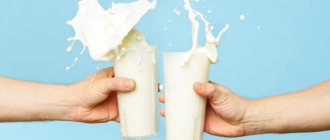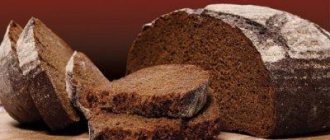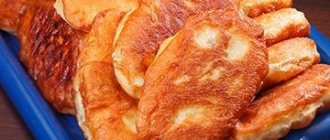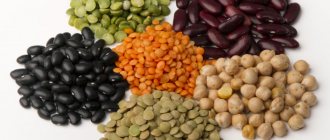Cookies are a small confectionery product made from dough, which can be either salty (crackers) or sweet. The shapes of cookies are square, round, oval, in the form of stars, tubes and gingerbread men. This delicious product is filled with chocolate, custard, nuts, ginger, raisins, condensed milk, various seeds and poppy seeds. Cookies can be hard or soft, filled with glaze on top or filled from the inside, and there are cookies without any additives at all.
Cookies containing sugar or white chocolate are high in calories, so this product is not suitable for those who want to lose weight. However, there are cookies produced specifically for diabetics: they contain glucose instead of sugar, so the calorie content of this type of cookie will be much lower than that of its “sugar” counterparts. There are also special dietary cookies. For its preparation, whole grain wheat, corn or oatmeal is used. Such a dietary delicacy, regardless of how many calories are in the cookies, will not cause any particular harm to the figure if consumed in small quantities.
Based on the method of preparation and consistency of the dough, the following types of cookies are distinguished:
- Dry or lingering:
- Sugar;
- Butter, which in turn can be whipped, shortbread, oatmeal or puff pastry.
Chemical composition of cookies
What components are included in the mixture for making cookies, and what substances does it consist of, which is tasty, but not the healthiest product? It is impossible to fit all existing cookie recipes into one article, because there are simply too many to count. Almost every country has its own traditional varieties of cookies, the recipe of which is customized by the owner or manufacturer. And although additional ingredients may vary depending on the recipe, the main components remain unchanged - flour, eggs, oil (vegetable or butter), sugar and salt. Depending on the recipe and type of cookies, honey, sour cream, dried fruits, nuts, cottage cheese, cocoa, and chocolate can be added. These products themselves are high in calories; it is not surprising that, when “combined” together, they turn into not the most dietary product.
The calorie content of cookies is also affected by the type of flour used to prepare the delicacy. The most high-calorie cookies are made from wheat flour, and instead of it or in combination with it, rye, corn, oatmeal, or wholemeal flour can be used. To reduce calories, sugar is sometimes replaced with honey or fructose.
Cookies have a high calorie content per 100 grams, but at the same time contain many useful substances. It is rich in B vitamins, vitamins A and E, contains calcium, sodium, phosphorus, magnesium, potassium, iron. Oatmeal cookies also contain a lot of fiber, so some of its varieties can be eaten even on a diet, of course, in moderation.
An approximate BJU of cookies looks like this:
- Proteins – 7.5 g
- Fat – 11.8 g
- Carbohydrates – 74 g
The nutritional value of the product, as well as the calorie content, changes in accordance with the cooking recipe.
The benefits and harms of cookies
First of all, the benefit of cookies lies in its composition.
. The chemical composition of cookies contains an abundance of vitamins such as B, PP, and it also contains iron, potassium, organic acids and phosphorus. Very often, children's doctors advise parents to give their children cookies as a source of energy. The benefits of cookies are obvious; in addition, nuts and dried fruits are used in their production, which also contain additional beneficial substances and vitamins.
If you look from the other side, cookies can cause quite significant harm to children’s bodies.
. This can happen if your child uncontrollably gorges on sweet treats. If you frequently consume cookies that contain large amounts of sugar, your teeth may deteriorate and you may experience digestive problems. However, cookies can also be harmful to adults.
Today, modern manufacturers rarely think about whether their cookies will be beneficial or harmful. Very often in its production they use quite fatty and heavy oil, which can lead to obesity. And also, without remorse, they add preservatives, dyes and chemical additives to cookies
.
There is a way out of this situation - please your loved ones with homemade cookies. You can prepare it from good ingredients. Cookies made at home will be much healthier and tastier.
And you can be sure that it will not harm the health of your loved ones.
The main thing is that before eating, you know and remember how many calories a particular cookie contains! Then your figure will remain as slim and attractive.
Nutritional and energy value of cookies
There are several main types of cookie dough:
- Sugar – sweet and fragile
- Shortbread - hard, crumbly, fatty, contains a lot of butter
- Butter - sweet, it contains a lot of butter and eggs
- Puff
- Lingering has an elastic and dense texture, not very sweet and greasy
- Whipped
- Oatmeal - oatmeal is added to wheat flour, the cookies are hard and moderately sweet
The more sugar, butter and other fats in the dough, the higher the calorie content of the cookies. Products made only from wheat flour, without the addition of other types, have the maximum calorie content.
The calorie content of cookies can vary greatly depending on the type of dough and additional components in the composition. Some types of cookies may have only 200 kcal per 100 grams, while others have 500 units. Therefore, if you want to know the calorie content of 1 cookie or 100 grams, study the energy value of the specific type of cookie you are going to eat. Do not rely on the approximate figure of 400 kcal per 100 grams.
How many calories are in cookies
Undoubtedly, the puff pastry takes the lead in terms of caloric content of cookies. Containing a huge amount of fat - 50% of the total energy value - and sugar, it is loved by children and adults due to its airiness and delicate taste. But, unfortunately, in such cookies the calories are visible to the naked eye: there are as many as 520 kcal per 100 g. And yet, there is a certain charm in it: if there is a catastrophic lack of time, it is the easiest way to prepare cookies from a frozen layer of puff pastry. You can simply roll out the semi-finished product, cut it into many small squares, sprinkle with sugar and cinnamon, put it in the oven and forget for half an hour. This method saves great time, and you will be able to please unexpected guests without any extra effort. However, those losing weight are not recommended to indulge in puff pastries. Its calorie content is not so bad, but there are absolutely no useful elements in it that will justify it. Therefore, if you can’t completely give up puff squares, triangles or ears, you should reduce their consumption to a maximum of twice a month.
The baton is taken over by butter cookies, whose calorie content is 451 kcal. In terms of energy value, its fat content is lower than that of its puff counterpart, and is only 34%, but carbohydrates instantly jump to 61%. Moreover, in this case, these are the same slow carbohydrates that those losing weight should avoid, especially in the afternoon and at night. And yet, butter cookies remain the most popular among Russians due to the high assortment for every taste and budget, as well as the fact that they occupy the largest share among all types of cookies on the shelves. Crumbly sugary or not having such a pronounced taste, lingering, two-colored, with the addition of nuts, sesame seeds or cereals, sprinkled with sugar or white glaze. Depending on the additives, the calories contained in the cookies will increase or decrease.
Many people mistakenly assume that oatmeal cookies have the lowest calorie content. And here, unfortunately, they will be disappointed. Yes, oatmeal is undoubtedly a healthy and dietary product, but store-bought oatmeal cookies will have a calorie content of 437 kcal per 100 g for the simple reason that they can be called butter-oat cookies due to the other ingredients in the composition. There are eggs, premium flour, a ton of sugar, and a ton of various flavorings along with emulsifiers. With this recipe, it would be hard to call oatmeal cookies a product for losing weight. Naturally, it’s better to eat a couple of such cookies than to carry puff pastry “ears” out of a box, but it’s even better to make your own oatmeal cookies, the caloric content of which you can control personally. As for the purchased option, and most non-dietary homemade recipes, carbohydrates lead in energy value with a value of 66%. This is followed by 30% fat and only 4% protein.
If you think about how many calories are in shortbread cookies, it will be strange to learn that they are lighter than butter cookies: 407 kcal per 100 g. Although almost every housewife knows how much butter or margarine it contains, there are significantly fewer ingredients in it than in other types, and therefore the calorie content of cookies is lower. But there are already 72% carbohydrates, which exceeds their amount in butter and puff pastries. So shortbread cookies cannot be called safe. But by varying the amount of oil at home and partially replacing it with water, you can get a lighter version of it in terms of fat content, reducing this figure from 21% to 17-15%. In addition, in order not to be so afraid that the cookies' calories will be deposited in problem areas, you can choose options with ginger or cinnamon: they are especially popular during the Christmas period. Of course, these two spices will not reduce the calorie content of cookies, but they help burn fat, which means that what you eat will be a little less harmful. But not enough to relax and lose half a kilo at a time.
And the lightest cookies, as well as the safest, would probably be correctly called biscuits. The percentage of proteins, fats and carbohydrates in it looks like 10%: 23%: 67%, which allows us to talk about its relative usefulness. Hearty and dry, biscuit cookies, whose calorie content barely reaches 390 kcal, have long been the choice of those who monitor their health and weight. Moreover, for people with severe dietary restrictions due to serious problems with the gastrointestinal tract, only this option of flour products is acceptable. But the niche of biscuits is occupied not only by unleavened “flatbreads” made from flour, water and salt, but also by crackers: plain, onion, cheese, with poppy seeds - sometimes they exceed the usual number of calories of biscuits, but not enough to equal, for example, the same rich one. Therefore, relative to the figure, even crackers will cause less harm than all other options.
Calorie content of oatmeal cookies
It’s not for nothing that we used the title in the plural; there are several types of oatmeal cookies, the calorie content of which, for this reason, is also completely different.
The calorie content of oatmeal cookies is high - 440 kcal per 100 grams. On average, 1 piece weighs 27 grams, respectively, the approximate calorie content of 1 oatmeal cookie is 140 units. At the same time, the product is useful for digestion, because it contains a lot of fiber. Coarse dietary fiber cleanses the intestinal walls, stimulates its functioning, fills the stomach, giving a feeling of fullness. Therefore, confectionery products prepared with the addition of oatmeal are sometimes consumed even on a diet. But for weight loss, it is better to enjoy dietary varieties of oatmeal cookies. To prepare it, wheat flour is diluted with rye, oat, or wholemeal flour. You can buy oatmeal in a store, or you can get it yourself by simply grinding oatmeal in a coffee grinder. Sometimes wheat flour is not used at all, so oatmeal cookies will be even less nutritious. The recipe does not include the use of butter or even sugar. Sweetness is obtained by adding honey.
To make your own oatmeal cookies, you will need:
- Glass of oatmeal
- 2 tbsp. honey
- 2 egg whites
- A little salt
Such cookies will have a calorie content of 345 units. per 100 grams. It will be harsh and not very sweet, but it will be as healthy as possible. If you add butter or vegetable oil, wheat flour, kefir, chocolate or dried fruits to the recipe, the product will be more tasty, but not as dietary.
Cookies without harm to your figure
The best way to avoid gaining weight from cookies is to not eat them. But this option, of course, is too cruel. After all, how can you imagine, for example, a New Year's table without Christmas ginger stars? And sometimes I just really want a mug of hot tea and a little “harm.” Then the solution would be to try to cook it yourself. In this case, the calorie intake of cookies can be monitored personally, eliminating everything that is excluded to the maximum. Starting from the statement that the most dietary delicacy is oatmeal cookies, it is worth recalling at least one low-calorie recipe. By and large, almost any homemade option will be more useful than a store-bought one. But if you want to reduce the calorie content of cookies as much as possible, then instead of butter as a binding ingredient it is better to add honey, and instead of a whole egg - white. Replace sugar with brown sugar or omit it altogether, instead grating an apple into a cup. The basis of everything is wheat and oat flour, the proportions can be varied, as well as oatmeal, a spoonful of dark raisins, an egg for viscosity, water, a little oil and soda. If desired, add cinnamon. As a result, homemade oatmeal cookies can have a calorie content of only 375 kcal per 100 g. And, of course, it is worth remembering that additives like chocolate, caramel, nuts and dried fruits increase the calorie content of cookies.
Cookies are a product that everyone loves since childhood. It is impossible to imagine a tea party or party without it. A wide variety of types and varieties of cookies allows you to choose the appropriate delicacy depending on the specific occasion and taste preferences.
How many calories are in cookies?
Various components can be selected to prepare cookies. The combination and proportion of ingredients will determine the cookies. The calorie content of cookies can be approximately judged based on the following factors:
- Type and type of flour. The use of white wheat flour results in high-calorie cookies. Rye, oatmeal, coarse wheat and buckwheat flour help make products with less calories.
- Type of test. Calorie content increases as fats, eggs, and sugar are added to the dough.
- Type of filling. The use of filling increases the calorie content of the cookies.
There are many varieties of simple cookies that have low calorie content and are therefore allowed to be consumed in moderation during diets and fasting days.
How many calories are in shortbread cookies?
Is one of the most popular. Many types of these soft, crumbly cookies are made using filling. The classic version of shortcrust pastry is prepared using eggs, flour, butter or margarine, sugar and soda. Sometimes cookies may contain sour cream or rendered pork fat. The calorie content of such cookies without filling can vary between 370-390 kcal. Nuts will increase the calorie content of cookies to 405-410 units, and adding filling will increase the calorie content to 415 kcal. If sour cream, cocoa, and sugar are added to the cookies, the calorie content can approach 430 units.
How many calories are in chocolate chip cookies?
Cocoa can be added to various types of cookies. For 100 g of dough there is usually 1 tbsp. cocoa. This gives a calorie increase of 25 units. On average, chocolate chip cookies have over 400 calories.
How many calories are in puff pastry?
The calorie content of puff pastry can vary greatly, but it will always be above 400 units. But some types of cookies, for example, puff ears, contain about 520 kcal.
How many calories are in biscuits?
Galette cookies belong to the category of dietary products, since they contain grade 2 flour and a little confectionery fat. The calorie content of this type of cookie is 350 units.
How many calories are in dry biscuits?
Dry cookies are not as harmless for the figure as they might seem at first glance. The addition of various chemical additives and fats results in a caloric content exceeding 440 units.
What are biscuits?
Currently, this type of biscuits, such as biscuits, is used mainly for children's and dietary nutrition. This food product is produced using different types of wheat flour, salt, sugar, a small amount of yeast and baking powder. It can be stored for a long time, so it can be easily taken on long hiking trips and expeditions, long sea voyages and in the field. Biscuit cookies are called simple if fats and sugar are not used in their production, and also fatty if the content of this substance reaches about 18%. When making simple flour, second or first grade flour is used. If you need to lose weight, it is not recommended to consume a product with a high percentage of fat. Plain biscuits can be stored for about two years, while high-fat biscuits can retain their nutritional properties for about 6 months.
Biscuits help you lose weight
It is also worth noting that the calorie content of biscuits is quite low, in addition, it is a non-allergenic food product, thanks to which anyone can lose excess weight quite easily.
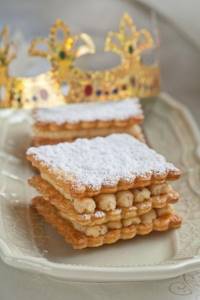
How to make biscuits at home
To prepare, you need to take 1 small egg, 1.5 tbsp. l. granulated sugar, odorless vegetable oil - 1 tbsp. l., milk - 1 tbsp. l., 1 tbsp. flour and 0.25 tsp. soda Once all the ingredients have been prepared, you can proceed directly to the process of preparing this dietary product. The recipe is very simple and quick:
- Mix baking soda with sifted flour.
- Mix the egg with granulated sugar, add milk, vegetable oil to this mixture and mix everything well until a homogeneous mass is obtained. Then add the mixed flour and soda. The result is a very tough dough that should not stick to your hands.
- The resulting dough should be rolled out into a very thin cake, approximately 1 mm thick. Next, use molds to make small cookies, pierce them with a fork and bake in an oven preheated to 220 degrees for about 5 minutes. And you need to keep them there until the surface acquires a light golden hue.
What to add
The end result will be cookies that are light and crispy. If your diet allows the use of cinnamon, zest or lemon juice, then it is recommended to add a small amount of these ingredients at the stage of kneading the dough. If you cannot tolerate egg yolks, then it is better to add one white to the dough; If you are intolerant to sugar or soda, it is better to remove them from the recipe altogether. If you simply don’t like the presence of vegetable oil, protein, or milk, then it is recommended not to add them at all, but to replace them with an equal amount of plain boiled water. It is also worth noting that this product becomes most dietary the next day after its preparation.
If we talk about the energy value of biscuits, their calorie content is quite high (especially in fatty varieties) and can reach almost 400 Kcal. However, due to the fact that it is quite dry, 100 g is not one, not two, or even 10 cookies. Conclusion: if you are on a diet, use homemade biscuits or look for low-fat varieties.
One of the favorite culinary flour products of many is Maria biscuits, which have a relatively low calorie content. It is its low calorie content that makes it so popular that even girls who prefer to go on diets can afford it.
Cookie Advantage
“Maria” cookies are not only not prohibited during a diet, but are even recommended to be consumed. After all, thanks to it, you can distract your body from eating extra portions that you so want to pamper yourself with. And, although biscuits do not have any special taste, they are simply ideal for tea and are very popular. This can also be explained by the fact that it perfectly retains its taste even after a long time, and therefore is irreplaceable on the road. Galette cookies can be classified as dietary culinary delicacies that help maintain a slim body.
How many calories are in Maria cookies?
It is quite difficult to calculate the calorie content of one Maria cookie. This is due to the fact that it is quite light and can have different shapes. On average, there are 390-400 kcal per hundred grams of product. The nutritional value is: 65 g of carbohydrates and 10 g of fat and protein.
The calorie content of Maria biscuits can be slightly increased if the composition includes. Some manufacturers may use various food additives that are aimed at improving taste, but in practice they contribute to the occurrence of allergic reactions in humans. Therefore, before making a purchase, you should study the label very carefully. In large quantities, the product can cause bloating and gas.
Nov-27-2012
Many of our readers probably know biscuit cookies from a variety called Maria cookies. This cookie does not have any exceptional taste, but at the same time, a considerable number of people are its fans. So, what are Maria cookies, the calorie content of which will be the topic of our publication? Let's first remember what biscuit cookies are.
Galette cookies are a type of flour confectionery product. Biscuits are dry, unsweetened cookies that have a flaky texture, for which premium wheat flour and some other types of flour, yeast, baking powder and some food additives are used. In preparation they use sponge technology.
Maria cookies also belong to this type of confectionery product. The calorie content of such a product is determined by its composition. Biscuits can be simple - without sugar and fat (crackers), with added fat (up to 18%) and dietary. Simple biscuits may not lose their properties for two years, while fat biscuits can last for about six months.
Galette cookies are easy to break into pieces and soak easily in water. It is often given a rectangular shape during manufacturing. You can freely take it with you on the road, since such a product can be stored for a long time without losing its original qualities.
What is the composition of this product?
100 grams of product contains approximately 10 grams of proteins and fats, 65 grams of carbohydrates, and the rest is water. Diet varieties of biscuits may have lower nutritional value. If we try to calculate the calorie content of one “cookie” (which is quite difficult - after all, they can have different shapes and sizes), then the total calorie content of Maria cookies should be divided by approximately 30. Based on all this, we conclude that this delicacy is of great harm to the figure will not bring, but it will satisfy hunger remarkably.
All types of such cookies are very pleasant in their taste, but at the same time they are also the healthiest of those that we buy in the store. And the main ingredients for making such cookies are just water and flour. Therefore, such cookies will not cause an allergic reaction, have low calorie content and good dietary properties.
Maria cookies are an excellent element of the diet of nursing mothers, pregnant women, young children, patients with diabetes, as well as those who suffer from diseases of the gastrointestinal tract.
The rich vitamin composition of premium flour used to create cookies of this type makes it possible to compensate for the lack of B vitamins in the body, as well as PP, N. The lack of these substances in the body can cause disruption of the functioning of certain systems, in particular the nervous system, and also negatively affects skin condition. In addition, Maria cookies are a source of a large number of microelements - calcium and potassium, magnesium, zinc, phosphorus, iodine, fluorine. All of them are extremely important for maintaining the proper functioning of the body.
Another very important component contained in flour, and accordingly in cookies, is fiber. It is necessary for proper bowel function. Flour is also a healthy source of large amounts of essential amino acids and unsaturated fats.
Well, specifically, how many calories are in Maria cookies? Here's how much:
Calorie content of shortbread cookies
One cookie that is definitely not dietary is shortbread. It has a very delicate, fragile structure, a very sweet taste, literally melts in your mouth. The price for this pleasure is high calorie content, because the confectionery product contains wheat flour, egg yolks, a lot of butter or margarine, to which sour cream or cottage cheese can also be added. Remember the appearance and taste of the famous kurabiye cookies, which are a prominent example of a confectionery product made from shortcrust pastry. Shortbread cookies can be prepared with filling - jam or preserves, nuts and even fruit are used for this.
Therefore, shortbread cookies are very high in calories - approximately 470 units per 100 grams. This confectionery delicacy is clearly not suitable for a diet.
Cottage cheese cookies also have a definitely high calorie content, 340 units per 100 grams.
Sugar cookies
Another type of high-calorie cookies is sugar cookies. As the name implies, a lot of sugar is used for cooking - 125 grams (+30 grams of vanilla sugar) per 100 grams of flour. There is as much oil as sugar, which also affects the energy value of the product. It is not surprising that sugar cookies have a caloric content of 400 units per 100 grams, the cookies are incredibly tasty and melt in the mouth, but there is definitely no place for the product on the dietary table.
Baked milk cookies are another embodiment of an anti-diet. The calorie content of the product exceeds 500 units per 100 grams, and one piece will contain about 100 kcal.
Chocolate cookies are considered high in calories. It can be prepared with the addition of cocoa powder, or using ready-made chocolate. Calorie content of chocolate cookies is 500 units, with chocolate – 514 units.
Sesame cookies - calorie content is about 445 units, so they are also not the most welcome guest on the dietary table.
The calorie content of Maria biscuits is on average 300-350 kcal per hundred grams
Just 100 grams of Maria cookies contain about 400 kcal. And since such cookies weigh quite little, it is not even possible to give an exact figure for the calorie content of one such cookie. This is determined by its size - approximately the indicated number of calories can be divided by 30, if one “cookie” is half the size of a small woman’s palm. Therefore, such cookies will not be particularly harmful to your figure, because they successfully curb hunger.
Can these cookies be made at home? Can! Here's the recipe for you:
Energy value of cookies from famous manufacturers
Cookies "Yubileinoe" are a bright representative of sugar cookies. The product is well known to almost all Russians; the packaging and characteristic taste are familiar from childhood. The delicacy has many fans, because it melts in the mouth, has a delicate structure, and is easy to snack on. However, not everyone knows that the product is high in calories. Jubilee cookies have a calorie content of about 472 units per 100 grams. One cookie weighs approximately 14 grams, therefore, the calorie content of 1 piece of Yubileiny is 57 units.
- Jubilee Morning Cookies - calorie content 457 units per 100 g
- Cookies Maria calorie content – 400 kcal per 100 g. Biscuits are made from premium quality wheat flour. The energy value of 1 Maria cookie is about 40 kcal (approximate weight 10 grams)
- Yashkino cookies - calorie content 500 units per 100 g
- Approximate calorie content of Lyubyatovo cookies (Maria biscuits and crackers) – 410 units
- Oreo cookies - calorie content 500 units per 100 grams
Recipe for making biscuits at home and its calorie content
To prepare biscuits you need the following ingredients:
- Milk 1.5% or water – 100 ml;
- Sugar or fructose – 40 g;
- Vanillin – 1 tsp;
- Lemon juice – 1 tbsp;
- Corn starch – 40 g;
- Coarse wheat flour – 40 g;
- Premium wheat flour – 160 g;
- Soda – 0.25 tsp;
- Refined sunflower oil – 30 ml.
Calorie content of biscuits
, prepared with water and fructose, is
300 kcal.
Sugar - 40 g or fructose must be dissolved in milk or water, then add 30 ml of refined oil. If milk and sugar are used in preparation, then the calorie content of the cookies will be 357 kcal. Next, premium and coarsely ground wheat flour is added to the resulting liquid. Everything is mixed well. Then corn starch and vanillin are poured into the semi-finished dough, and a quarter tsp is also quenched. soda and lemon juice. The dough is thoroughly kneaded and left to rest for half an hour or an hour. The finished dough is rolled out into a thin layer, approximately 2 mm thick, and cut into any shape (circles, squares or stars). Each cookie is pierced several times with a fork and placed on a baking sheet, greased and sprinkled with flour or semolina. Prepare homemade biscuits, the calorie content of which is 40 kcal per piece, for 7-10 minutes in the oven preheated to 180°C. Ready-made cookies can be combined with hot chocolate, honey, any jam or jam.
What cookies can you eat on a diet?
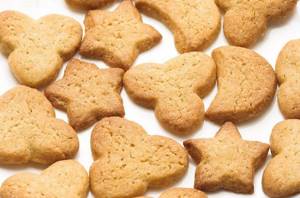
Some types of crackers and other biscuits can be consumed in small quantities while following a diet. For example, crackers can be used as a substitute for bread, but you can only eat a few a day.
Oatmeal cookies made without oil or with minimal oil content can also be included in the diet. Lenten cookies, the calorie content of which is approximately 314 units. per 100 grams, you can also sometimes eat it while following a diet. Just choose recipes where vegetable oil is either absent or a little is added.
Ginger cookies, whose calorie content is slightly more than 400 units, can be allowed occasionally on a diet. Ground ginger, especially in combination with cinnamon, will add new flavor notes to the product, so you can prepare a tasty, aromatic and low-calorie product. If you add seasonings to biscuits, you get a good dietary option.
Which cookies are better to forget about when following a diet? Butter, shortbread, “Yubileinoe”, “Domashneye”, with seeds and sesame, with condensed milk, sugar, the calorie content is too high to be allowed on the dietary table. The calorie content of 1 cookie will be too high to indulge yourself without a twinge of conscience with these products while following a diet.
Oatmeal cookies with seeds (with bran)
Many ingredients can change the taste of the main product or dish beyond recognition and affect its energy value.
The number of calories in 1 piece of oatmeal cookies with added bran is 75 units.
But if you add sunflower seeds, the picture will change.
1 piece of oatmeal cookies with seeds - 105 kcal.
That is, 100 g of cookies with the addition of sunflower seeds contains 460 kcal
. This number can be halved if you use this dietary recipe for cooking.
We will need:
- oat flakes 200 g;
- kefir with 0% fat content 200 g;
- honey 40 g;
- sunflower seeds 80 g;
- egg 2 pcs.
Mix all ingredients well, place on a baking sheet covered with parchment, and bake in the oven for about half an hour at 190 degrees.
The calorie content of one hundred grams of the resulting delicious cookies will not exceed 200 kcal.
